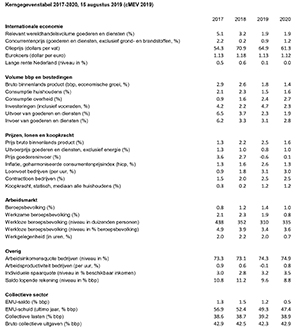Table Main Economic Indicators 2017-2020
Economic growth down to 1.4% by 2020

These projections are the Cabinet’s starting point for the concluding decision-making process about the draft budget 2020, including next year’s purchasing power. On Prinsjesdag (the day of the King's Speech in which the main features of government policy for the coming parliamentary session are announced; this year on 17 September), CPB’s Macro Economic Outlook 2020 (MEV) will be published, including an explanation of the projections and a detailed analysis of the Dutch economic situation.
CPB’s Director, Laura van Geest, states: ‘The economic turning point is behind us. The pace is slowing down. Unemployment will remain low, but employment growth will level off, substantially — in particular in the market sector. The Dutch economy is driven predominately by domestic spending, exports are affected by the fall out from developments in other countries.”
| 2018 | 2019 | 2020 | |
| GDP growth down to 1.4% | 2.6 | 1.8 | 1.4 |
| Unemployment at lowest point in 2019 | 3.9 | 3.4 | 3.6 |
| Inflation down in 2020 | 1.6 | 2.6 | 1.3 |
| Higher increase in contract wages to continue | 2.0 | 2.5 | 2.5 |
| Increase in purchasing power will continue in 2020, thanks to real wages | 0.2 | 1.2 | 1.2 |
| Government budget surplus will decline | 1.5 | 1.2 | 0.5 |
The labour market is projected to remain tight. The slowdown in production growth will first become apparent from the lower increase in labour productivity. In 2020, employment growth will decline under a continuing increase in labour supply. This will end the decrease in unemployment.
The substantial downward economic risks have increased further. US trade policy and the responses to this policy, the growing possibility of a chaotic Brexit, and the political developments in Italy are all significant threats to the Dutch economy.
The way the detailed figures on purchasing power are presented has changed. These August Projections for the year 2019 are presented in both the old and the new way (see downloads below).
The Dutch Cabinet uses the cMEV as a basis for its August decisions on next year’s purchasing power. On 17 September 2019, the day of the King's Speech in which the main features of government policy for the coming parliamentary session are announced ("Prinsjesdag"), the Macro Economic Outlook 2020 (MEV) will be published, containing the final projections and their explanation, as well as a detailed analysis of the Dutch economic situation.
Downloads
Table 'Main economic indicators', 2017-2020, 15 August 2019
|
International items |
2017 | 2018 | 2019 | 2020 |
| Relevant world trade volume goods and services (%) | 5.1 | 3.2 | 1.9 | 1.9 |
| Export price competitors (goods and services, non-commodities, %) | 2.2 | 0.2 | 0.9 | 1.2 |
| Crude oil price (dollar per barrel) | 54.3 | 70.9 | 64.9 | 61.3 |
| Exchange rate (dollar per euro) | 1.13 | 1.18 | 1.13 | 1.12 |
| Long-term interest rate the Netherlands (level in %) | 0.5 | 0.6 | 0.1 | 0.0 |
|
GDP and demand (volume) |
2017 | 2018 | 2019 | 2020 |
| Gross domestic product (GDP, economic growth, %) | 2.9 | 2.6 | 1.8 | 1.4 |
| Household consumption (%) | 2.1 | 2.3 | 1.5 | 1.6 |
| Government consumption (%) | 0.9 | 1.6 | 2.4 | 2.7 |
| Capital formation (including changes in stock, %) | 4.2 | 2.2 | 4.7 | 2.3 |
| Exports of goods and services (%) | 6.5 | 3.7 | 2.3 | 1.9 |
| Imports of goods and services (%) | 6.2 | 3.3 | 3.1 | 2.8 |
|
Prices, wages and purchasing power |
2017 | 2018 | 2019 | 2020 |
| Price gross domestic product (%) | 1.3 | 2.2 | 2.5 | 1.6 |
| Export price goods and services (non-energy, %) | 1.3 | 1.0 | 0.8 | 1.0 |
| Import price goods (%) | 3.6 | 2.7 | -0,6 | 0.1 |
| Inflation, harmonised index of consumer prices (HICP, %) | 1.3 | 1.6 | 2.6 | 1.3 |
| Compensation per hour private sector (%) | 0.9 | 1.8 | 3.1 | 3.0 |
| Contractual wages private sector (%) | 1.5 | 2.0 | 2.5 | 2.5 |
| Purchasing power, static, median, all households (%) | 0.3 | 0.2 | 1.2 | 1.2 |
|
Labour market |
2017 | 2018 | 2019 | 2020 |
| Labour force (%) | 0.8 | 1.2 | 1.4 | 1.0 |
| Active labour force (%) | 2.1 | 2.3 | 1.9 | 0.8 |
| Unemployment (in thousands of persons) | 438 | 352 | 310 | 335 |
| Unemployed rate (% of the labour force) | 4.9 | 3.9 | 3.4 | 3.6 |
| Employment (hours, %) | 2.0 | 2.2 | 2.0 | 0.7 |
|
Other items |
2017 | 2018 | 2019 | 2020 |
| Labour share in enterprise income (level in %) | 73.3 | 73.1 | 74.3 | 74.9 |
| Labour productivity private sector (per hour, %) | 0.9 | 0.6 | -0.1 | 0.8 |
| Private savings (% of disposable household income) | 3.0 | 2.8 | 3.2 | 3.5 |
| Current-account balance (level in % GDP) | 10.8 | 11.2 | 9.6 | 8.8 |
|
Public sector |
2017 | 2018 | 2019 | 2020 |
| General government financial balance (% GDP) | 1.3 | 1.5 | 1,2 | 0.5 |
| Gross debt general government (% GDP) | 56.9 | 52.4 | 49.3 | 47.4 |
| Taxes and social security contributions (% GDP) | 38.6 | 38.7 | 39.2 | 38.9 |
| Gross government expenditure (% GDP) | 42.9 | 42.5 | 42.3 | 42.9 |
